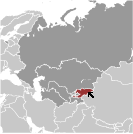World Atlas: Kyrgyzstan. On this page you can see the map, country flag and many detailed information about the people, history and economy of Kyrgyzstan.

Here you can find online selected information about the geography, inhabitants, government, economy and history of Kyrgyzstan. Included are selected statistics, an overview map and the detailed map of Kyrgyzstan. But let's start with the flag of Kyrgyzstan here:
Kyrgyzstan - Overview:
What you should know about Kyrgyzstan? Let's start with this: A Central Asian country of incredible natural beauty and proud nomadic traditions, most of the territory of present-day Kyrgyzstan was formally annexed to the Russian Empire in 1876. The Kyrgyz staged a major revolt against the Tsarist Empire in 1916 in which almost one-sixth of the Kyrgyz population was killed. Kyrgyzstan became a Soviet republic in 1936 and achieved independence in 1991 when the USSR dissolved. Nationwide demonstrations in 2005 and 2010 resulted in the ouster of Kyrgyzstan’s first two presidents, Askar Akaev and Kurmanbek Bakiev. In 2017, Almazbek Atambaev became the first Kyrgyzstani president to step down after serving a full term as required in the country’s constitution. Former Prime Minister and ruling Social-Democratic Party of Kyrgyzstan member Sooronbay Jeenbekov replaced him after winning an October 2017 presidential election that was the most competitive in Kyrgyzstan’s history, although it was marred by allegations of illicit government interference to benefit Jeenbekov. The president holds substantial powers as head of state even though the prime minister oversees Kyrgyzstan’s government and selects most cabinet members. The president represents the country internationally and can sign or veto laws, call for new elections, and nominate supreme court judges, cabinet members for posts related to security or defense, and numerous other high-level positions. Continuing concerns for Kyrgyzstan include the trajectory of democratization, endemic corruption, poor interethnic relations, border security vulnerabilities, and potential terrorist threats.
Geography of Kyrgyzstan
 Where on the globe is Kyrgyzstan? The location of this country is Central Asia, west of China, south of Kazakhstan. Total area of Kyrgyzstan is 199,951 sq km, of which 191,801 sq km is land. So this is not a large country. How could we describe the terrain of the country? This way: peaks of the Tien Shan mountain range and associated valleys and basins encompass the entire country. The lowest point of Kyrgyzstan is Kara-Daryya (Karadar'ya) 132 m, the highest point Jengish Chokusu (Pik Pobedy) 7,439 m. And the climate is dry continental to polar in high Tien Shan Mountains; subtropical in southwest (Fergana Valley); temperate in northern foothill zone.
Where on the globe is Kyrgyzstan? The location of this country is Central Asia, west of China, south of Kazakhstan. Total area of Kyrgyzstan is 199,951 sq km, of which 191,801 sq km is land. So this is not a large country. How could we describe the terrain of the country? This way: peaks of the Tien Shan mountain range and associated valleys and basins encompass the entire country. The lowest point of Kyrgyzstan is Kara-Daryya (Karadar'ya) 132 m, the highest point Jengish Chokusu (Pik Pobedy) 7,439 m. And the climate is dry continental to polar in high Tien Shan Mountains; subtropical in southwest (Fergana Valley); temperate in northern foothill zone.
Inhabitants of Kyrgyzstan
Let's take a look how many people live in Kyrgyzstan. The number is: 5,789,122 (July 2017 est.). So this is not very populous country. Who lives here? Kyrgyz 73.2%, Uzbek 14.6%, Russian 5.8%, Dungan 1.1%, other 5.3% (includes Uyghur, Tajik, Turk, Kazakh, Tatar, Ukrainian, Korean, German) (2017 est.). What are the languages in Kyrgyzstan? Kyrgyz (official) 71.4%, Uzbek 14.4%, Russian (official) 9%, other 5.2% (2009 est.). And the religions: Muslim 75%, Russian Orthodox 20%, other 5%. How old are the people in average? 26.5 years. We have to add that this number is the median - so one half of the people is older than this, one half is younger. And what is their life expectancy (at birth)? This: 70.9 years. Where the people live in Kyrgyzstan? Here: the vast majority of Kyrgyzstanis live in rural areas; densest population settlement is to the north in and around the capital, Bishkek, followed by Osh in the west; the least densely populated area is the east, southeast in the Tien Shan mountains. The major urban areas of Kyrgyzstan are: Bishkek (capital) 865,000 (2015).
Government and Economy of Kyrgyzstan
The capital of Kyrgyzstan is Bishkek and the government type parliamentary republic. Let's take a look at the administrative divisions - 7 provinces (oblustar, singular - oblus) and 2 cities (shaarlar, singular - shaar); Batken Oblusu, Bishkek Shaary, Chuy Oblusu (Bishkek), Jalal-Abad Oblusu, Naryn Oblusu, Osh Oblusu, Osh Shaary, Talas Oblusu, Ysyk-Kol Oblusu (Karakol). Regarding the economy of Kyrgyzstan, important industrial products are small machinery, textiles, food processing, cement, shoes, lumber, refrigerators, furniture, electric motors, gold, rare earth metals. Important agricultural products are cotton, potatoes, vegetables, grapes, fruits and berries; sheep, goats, cattle, wool. The most important export commodities are gold, cotton, wool, garments, meat; mercury, uranium, electricity; machinery; shoes and the most important export partners are Switzerland 44.9%, Kazakhstan 10.5%, Russia 10.1%, Uzbekistan 8.7%, Turkey 6.2%, China 5.5% (2016). The most important import commodities are oil and gas, machinery and equipment, chemicals, foodstuffs and the most important import partners are China 37.8%, Russia 20.7%, Kazakhstan 16.4%, Turkey 4.9% (2016). How rich is Kyrgyzstan and how rich are people in this country? The most important number here is GDP per capita (PPP): $3,700 (2017 est.). This is a very low number. Let's add that this means Gross Domestic Product per person, which is recalculated with respect to the relative cost of local goods and services. And one more important number - population below poverty line: 32.1% (2015 est.).